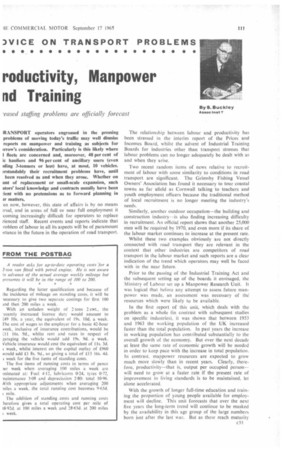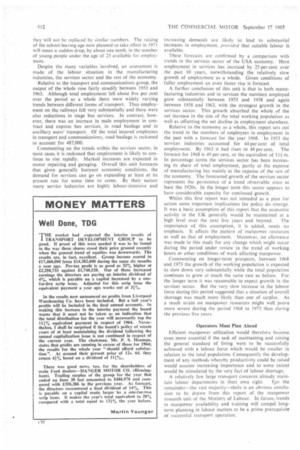)VICE ON TRANSPORT PROBLEMS
Page 111

Page 112

If you've noticed an error in this article please click here to report it so we can fix it.
roductivity, Manpower nd Training
wised staffing problems are officially .forecast
By S. Buckley
Assoc lnst T 1RANSPORT operators engrossed in the pressing problems of moving today's traffic may well dismiss reports on manpower and training as subjects for Irrow's consideration. Particularly is this likely where I fleets are concerned and, moreover, 48 per cent of ic hauliers and 96 per cent of ancillary users (even sling 3-tonners or less) have, at most, 10 vehicles. arstandably their recruitment problems have, until been resolved as and when they arose. Whether on ant of replacement or small-scale expansion, such Ettors' local knowledge and contracts usually have been ient with no pretensions as to forward planning in Lir matters.
en now, however, this state of affairs is by no means .trsal, and in areas of full or near full employment it coming increasingly difficult for operators to replace rienced staff. Recent events and reports indicate that Toblem of labour in all its aspects will be of paramount ance in the future in the operation of road transport.
The relationship between labour and productivity has been stressed in the interim report of the Prices and Incomes Board, whilst the advent of Industrial Training Boards for industries other than transport stresses that labour problems can no longer adequately be dealt with as and when they arise.
Two recent random items of news relative to recruitment of labour with some similarity to conditions in road transport are significant. The Grimsby Fishing Vessel Owners' Association has found it necessary to tour coastal towns as far afield as Cornwall talking to teachers and youth employment officers because the traditional method of local recruitment is no longer meeting the industry's needs.
Similarly, another outdoor occupation—the building and construction industry--is also finding increasing difficulty in recruitment. An official report shows that another 25,000 Men will be required by 1970, and even more if its share of the labour market continues to increase at the present rate.
Whilst these two examples obviously are not directly connected with road transport they are relevant in the context that other industries are competitors of road transport in the labour market and such reports are a clear indication of the trend which operators may well be faced with in the near future.
Prior to the passing of the Industrial Training Act and the subsequent setting up of the boards it envisaged, the Ministry of Labour set up a Manpower Research Unit. It was logical that before any attempt to assess future manpower was made, an assessment was necessary of thi resources which were likely to be available.
In the first report of this unit, which deals with the problem as a whole (in contrast with subsequent studies on specific industries), it was shown that between 1953 and 1963 the working population of the UK increased faster than the total population. In past years the increase in working population has contributed substantially to the overall growth of the economy. But over the next decade at least the same rate of economic growth will be needed in order to keep pace with the increase in total population. In contrast. manpower resources are expected to grow much more slowly than in recent years. Clearly, therefore, productivity—that is, output per occupied person— will need to grow at a faster rate if the present rate of improvement in living standards is to be maintained, let alone accelerated, With the growth of longer full-time education and training the proportion of young people available for employment will decline. This unit forecasts that over the next five years the long-term trend will continue to be masked by the availability in this age group of the large numbers born iusl after the last war. But as these reach maturity
they will not be replaced by similar numbers. The raising of the school-leaving age now planned to take effect in 1971 will mean a sudden drop, by about one tenth, in the number of young people under the age of 25 available for employment.
Despite the many variables involved, an assessment is made of the labour situation in the manufacturing industries, the services sector and the rest of the economy.
Relative to the transport and communications group, the output of the whole rose fairly steadily between 1953 and 1963. Although total employment fell about five per cent over the period as a whole there were widely varying trends between different forms of transport. Thus employment on the railways fell very substantially and there were also reductions in stage bus services, In contrast, however, there was an increase in male employment in contract and express bus services, in road haulage and in ancillary users' transport. Of the total insured employees in transport and communications, road haulage is reckoned to account for 487,000.
Commenting on the trends within the services sector, in most cases it is reckoned that employment is likely to continue to rise rapidly. Marked increases are expected in motor repairing and garaging. Overall this unit forecasts that given generally buoyant economic conditions, the demand for services can go on expanding at least at its present rate for some time to come. By their nature many service industries are highly labour-intensive and
increasing demands are likely to lead to substantial increases in employment, provided that suitable labour is available,
These forecasts are confirmed by a comparison with trends in the services sector of the USA economy. Here employment in services has increasd by 25 per cent over the past 10 years, notwithstanding the relatively slow growth of employment as a whole. Given conditions of fuller employment an even faster rise is forecast.
A further conclusion of this unit is that in both manufacturing industries and in services the numbers employed grew substantially between 1953 and 1958 and again between 1958 and 1963, with the strongest growth in the services sector. This growth absorbed the whole of the net increase in the size of the total working population as well as offsetting the net decline in employment elsewhere.
Relative to the economy as a whole, this report sets out the trend in the numbers of employees in employment in the past with a forecast for the year 1968. In 1953 the services industries accounted for 44 per cent of total
employment. By 1963 it had risen to 48 per cent. The forecast for 1968 is 49 per cent, or the equivalent of 111 m. In percentage terms the services sector has been increasing its share of total employment, partly at the expense of manufacturing but mainly at the expense of the rest of the economy. The forecasted growth of the services sector represents the persistence of a trend observable since at least the 1920s. In the longer term this sector appears to have considerable capacity for continued growth.
Whilst this first report was not intended as a plan for action some important implications for policy do emerge. It was a basic assumption of this report that the economic activity in the UK generally would be maintained at a
high level over the next live years and beyond. The importance of this assumption, it is added, needs no emphasis. It affects the pattern of maiipower resources as well as that of employment. Moreover, no allowance was made in this study for any change which might occur during the period under review in the trend of working hours or other conditions of work affecting manpower.
Commenting on longer-term prospects, between 1968 and 1973 the growth of the working population is expected to slow down very substantially while the total population continues to grow at much the same rate as before. For the longer term it was reasonable to expect growth in the services sector. But the very slow increase in the labour force during this period suggested that a situation of overall shortage was much more likely than one of surplus. As a result strain on manpower resources might well prove more severe during the period 1968 to 1973 than during the previous five years.
Operators Must Plan Ahead
Efficient manpower utilization would therefore become even more essential if the task of maintaining and raising the general standard of living were to be successfully achieved with a labour force which would be smaller in relation to the total population. Consequently the development of any methods whereby productivity could be raised would assume increasing importance and to some extent would be stimulated by the very fact of labour shortage.
A relatively few large transport concerns already main
tain labour departments in their own right. F.or the remainder—the vast majority—thei.e is an obvious conclusion to be drawn from this report of the manpower research unit of the Ministry of Labour. In future, trends in manpower availability and training will compel longterm planning in labour matters to be a prime prerequisite of successful transport operation.




















































































































































































